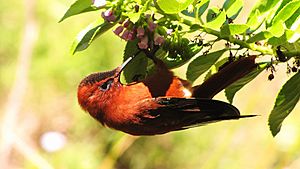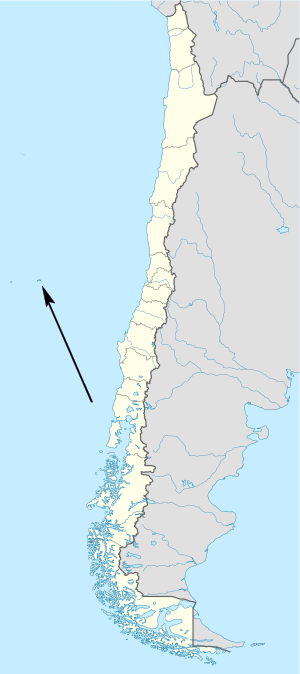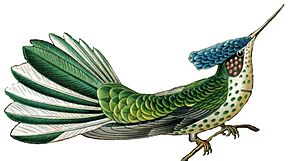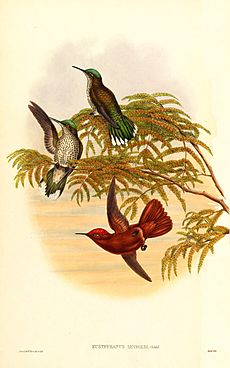Juan Fernández firecrown facts for kids
Quick facts for kids Juan Fernández firecrown |
|
|---|---|
 |
|
| Adult male feeding on Cuminia eriantha flowers | |
| Conservation status | |
| Scientific classification | |
| Genus: |
Sephanoides
|
| Species: |
fernandensis
|
 |
|
The Juan Fernández firecrown (Sephanoides fernandensis) is a very special and rare hummingbird. It lives only on Isla Róbinson Crusoe, which is part of the Juan Fernández archipelago near Chile. This beautiful bird is currently listed as Critically Endangered, meaning it's at a very high risk of disappearing forever.
Contents
About the Juan Fernández Firecrown's Family
The Juan Fernández firecrown belongs to a group of hummingbirds called Sephanoides. Its closest relative is the green-backed firecrown (S. sephaniodes).
Scientists usually recognize two types, or subspecies, of the Juan Fernández firecrown. One is the S. f. fernandensis, which is the one still alive today. The other, S. f. leyboldi, is sadly extinct. It used to live on Alejandro Selkirk Island, another island in the same group. However, some experts wonder if the extinct type really existed or if it ever lived on Alejandro Selkirk Island.
What the Juan Fernández Firecrown Looks Like
The Juan Fernández firecrown is one of the most unique hummingbirds because the males and females look so different. This is called "sexual dimorphism." In the past, people even thought they were different species!
Male firecrowns are about 11.5 to 12 centimeters (4.5 to 4.7 inches) long. They weigh around 10.9 grams (0.38 ounces). Their bodies are mostly a bright cinnamon-orange color. Their forehead and crown (the top of their head) are a shiny, fiery reddish-yellow. Their wings are a dark coppery-gray.
Female firecrowns are a bit smaller, about 10.5 centimeters (4.1 inches) long. They weigh about 6.8 grams (0.24 ounces). Their upper parts are bluish-green, and their crown is a shiny bluish-purple. Their belly is pure white with black and green spots. Their wings are a slaty green. The middle tail feathers are blue-green, and the outer parts of the other tail feathers are white. Both males and females have a straight, black beak.
Where the Juan Fernández Firecrown Lives
The living Juan Fernández firecrown subspecies is found only on Isla Róbinson Crusoe. The extinct subspecies, S. f. leyboldi, is thought to have lived on Alejandro Selkirk Island.
These hummingbirds live in forests, thick bushes, and gardens. They prefer shady spots. In the summer, you can often see the males in the island's only town, San Juan Bautista. They feed on the flowers of special trees called Dendroseris, which grow only on these islands. Many of these trees are also critically endangered. All known breeding areas for the firecrown are between 120 and 660 meters (390 and 2,170 feet) above sea level.
Juan Fernández Firecrown Behavior
Movement
The Juan Fernández firecrown moves around Isla Róbinson Crusoe. It likely does this to find flowering plants for food. However, it generally stays on the island and does not migrate.
Feeding Habits
The Juan Fernández firecrown drinks nectar from native plants. It especially likes Rhaphithamnus venustus and Sonchus brassicifolius flowers. When native plants are not blooming, especially in autumn and winter, it might also feed on introduced plants like Eucalyptus and Abutilon.
These birds feed by holding onto the flowers. They prefer shaded flowers that are high off the ground. Both male and female firecrowns protect their feeding areas. Males usually guard the best spots with more food. Besides nectar, they also eat small insects. They catch insects while flying or pick them off leaves.
Reproduction and Life Cycle
The breeding season for the Juan Fernández firecrown is from September to mid-November. The female builds a small cup-shaped nest. She uses fern fibers, other plant fibers, moss, and spiderwebs. The nest is usually placed on the tip of a twig, hidden by leaves. It is typically about 4 meters (13 feet) above the ground.
A study in 2011 found that over 75% of their nests were in Myrceugenia fernandeziana trees. The female usually lays two eggs. We don't know exactly how long the eggs take to hatch or how long it takes for the young birds to leave the nest.
Vocalization
The song of the Juan Fernández firecrown is a mix of different sounds. It includes high-pitched squeaky notes, dry, rough trills, and chattering sounds that go down in pitch.
Status and Conservation Efforts
The IUCN (International Union for Conservation of Nature) has listed the Juan Fernández firecrown as Critically Endangered. This means it faces a very high risk of extinction. The species lives on only one small island.
It's estimated that there are only about 1,500 to 3,500 adult birds left. The total number of individuals is thought to be between 3,000 and 5,200. This number is believed to be getting smaller.
Several things are causing their decline:
- Loss of native trees: The birds depend on these trees for nesting.
- Spread of non-native plants: Plants like zarzamora blackberry (Rubus ulmifolius) and maqui wineberry (Aristotelia chilensis) are taking over their habitat.
- Predators: Domestic and wild cats hunt the hummingbirds.
- Introduced animals: Rabbits and goats, brought to the island, destroy plants the birds rely on.
- Competition: The more common green-backed firecrown might compete with them for food.
To help save this species, a conservation project started in 2004. Several groups are working together, including The Hummingbird Society and American Bird Conservancy. Their efforts include:
- Planting native trees and plants.
- Removing non-native plants.
- Reducing the number of non-native predators and competitors.
Local island residents have been hired to help coordinate and work on these important conservation projects.
See also
 In Spanish: Picaflor de Juan Fernández para niños
In Spanish: Picaflor de Juan Fernández para niños




